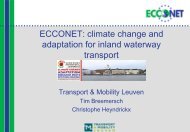Governing adaptation to natural hazards in land-use planning
Governing adaptation to natural hazards in land-use planning
Governing adaptation to natural hazards in land-use planning
You also want an ePaper? Increase the reach of your titles
YUMPU automatically turns print PDFs into web optimized ePapers that Google loves.
2nd Nordic International Climate Change Conference<br />
<strong>Govern<strong>in</strong>g</strong> <strong>adaptation</strong> <strong>to</strong> <strong>natural</strong><br />
<strong>hazards</strong> <strong>in</strong> <strong>land</strong>-<strong>use</strong> plann<strong>in</strong>g<br />
Trude Rauken and Asbjørn Aaheim<br />
CICERO<br />
Norway<br />
Hels<strong>in</strong>ki, August 30, 2012
Knowledge gaps <strong>in</strong> management of <strong>natural</strong> <strong>hazards</strong><br />
We know:<br />
• Natural processes and consequences<br />
• Most human responses can be expla<strong>in</strong>ed when put <strong>in</strong> context<br />
• Decision mak<strong>in</strong>g processes leave a big space for escap<strong>in</strong>g<br />
responsibility<br />
ISO 31 000: Quantitative assessments can still be improved, but<br />
qualitative assessments are equally important. Risk management<br />
needs <strong>to</strong> be <strong>in</strong>tegrated <strong>in</strong><strong>to</strong> the decision mak<strong>in</strong>g processes<br />
SREX: Management of <strong>natural</strong> <strong>hazards</strong> is a national responsibility,<br />
where the social and human dimensions need <strong>to</strong> be <strong>in</strong>tegrated<br />
But:<br />
• Few studies address how <strong>to</strong> <strong>in</strong>tegrate the different dimensions
Why would anyone res<strong>to</strong>re this ho<strong>use</strong> once the flood is over?<br />
Source: Heggelund/SCANPIX<br />
…but they will, and they do – so are they fools?
How are the losses compensated?<br />
Country Arrangement Risk vs premium<br />
Denmark<br />
F<strong>in</strong><strong>land</strong><br />
Norway<br />
Sweden<br />
Compulsory private <strong>in</strong>surance (connected <strong>to</strong> fire<br />
<strong>in</strong>surance). Ultimate state guarantee<br />
Private optional system. Compensation for<br />
<strong>natural</strong> hazard damages are offset annually on<br />
governmental budgets. Also a case-<strong>to</strong>-case<br />
evaluation<br />
Compulsory private <strong>in</strong>surance (connected <strong>to</strong> fire<br />
<strong>in</strong>surance). Assets outside the private <strong>in</strong>surance<br />
doma<strong>in</strong> guaranteed by a state fund<br />
Private bundled system. No state guarantee, but<br />
compensations are given on an ad-hoc basis<br />
Independent<br />
Private is<br />
dependent. Public is<br />
<strong>in</strong>dpendent<br />
Independent<br />
Independent<br />
…the citizens may expect <strong>to</strong> be partly or fully compensated
Roles and responsibilities<br />
Private developer: Economic losses are compensated.<br />
Permission for development is given by the municipality. What<br />
is the risk of life and health?<br />
Municipalities: The national level compensates economic losses.<br />
Give permissions on the basis of an evaluation of possible (local)<br />
economic risks and risks on life and health.<br />
National level: Make sure that municipalities <strong>in</strong>clude also the<br />
economic risks that will be compensated by the state <strong>in</strong> case of<br />
an event<br />
HOW <strong>to</strong> do this?
Natural <strong>hazards</strong> and <strong>land</strong> <strong>use</strong> plann<strong>in</strong>g<br />
Consider<strong>in</strong>g <strong>natural</strong> <strong>hazards</strong> <strong>in</strong> <strong>land</strong> <strong>use</strong> plann<strong>in</strong>g <strong>in</strong> municipality X<br />
Plann<strong>in</strong>g and Build<strong>in</strong>g Act<br />
Risk and Vulnerability Analysis<br />
Hazard maps<br />
Local knowledge<br />
Decision<br />
Other aims and concerns
Awareness at the national level<br />
Example A: Two people killed <strong>in</strong> an avalanche <strong>in</strong> an alp<strong>in</strong>e ski resort<br />
w<strong>in</strong>ter 2011. The M<strong>in</strong>ister of Environment is asked what can be<br />
done <strong>to</strong> avoid this <strong>in</strong> the future?<br />
The m<strong>in</strong>ister: «Put up protection walls where the avalanche<br />
occurred. Besides, the municipalities need <strong>to</strong> be more careful <strong>in</strong><br />
develop<strong>in</strong>g these resorts, and take more responsibility»<br />
Example B: Flood <strong>in</strong> Eastern Norway spr<strong>in</strong>g 2011. Insurance<br />
companies compla<strong>in</strong> about ho<strong>use</strong>s that are be<strong>in</strong>g built with<strong>in</strong><br />
flood zones. The M<strong>in</strong>ister of Justice is asked for a comment.<br />
The m<strong>in</strong>ister: «Is this supposed <strong>to</strong> be the message <strong>to</strong> people who<br />
have just lost their homes?»
Formalization of the government’s problem<br />
‣ The municipality knows that compensation is paid ex post. They <strong>in</strong>clude it <strong>in</strong><br />
their prior evaluation of risk, and impose less prior efforts <strong>to</strong> avoid losses<br />
‣ The national government has <strong>in</strong>sufficient <strong>in</strong>formation <strong>to</strong> dictate the<br />
appropriate level of efforts – the correspondence between risk and efforts is<br />
the municipality’s «private <strong>in</strong>formation» => Moral hazard<br />
‣ How can the national government encourage high efforts <strong>in</strong> municipalities?<br />
Prior<br />
evaluation<br />
Efforts<br />
Probabilities<br />
Broad<br />
Narrow<br />
Post<br />
evaluation<br />
Outcome<br />
Transfer<br />
Broad Ψ ex ante e H π H 1 - π H d Ψ ex post t H<br />
Narrow Φ ex ante e L π L 1 - π L D Φ ex post t L<br />
π H = Probability that high efforts <strong>in</strong> municipalities is based on a broad evaluation<br />
π L = Probability that low efforts <strong>in</strong> municipalities is based on a broad evaluation
Conclusions<br />
‣ In countries where damages for <strong>natural</strong> disasters are compensated<br />
<strong>in</strong>dependent of the private evaluation of risk, it is a national responsibility <strong>to</strong><br />
assure that damages do not exceed what can be expected on the basis of<br />
prior knowledge<br />
‣ The social costs of a national guarantee may very well be lower than the<br />
exceed<strong>in</strong>g costs related <strong>to</strong> moral hazard, which follows from such a guarantee<br />
‣ Unawareness of the moral hazard issue, national efforts <strong>to</strong> <strong>in</strong>crease security,<br />
such as improvement of warn<strong>in</strong>g systems, may <strong>in</strong>crease losses of <strong>natural</strong><br />
<strong>hazards</strong><br />
‣ The government may reduce the cost related <strong>to</strong> moral hazard by ex-post<br />
evaluations of local efforts<br />
‣ It is still a problem that developments with negative expected values <strong>in</strong> a<br />
national context may be considered valuable <strong>to</strong> a municipality






